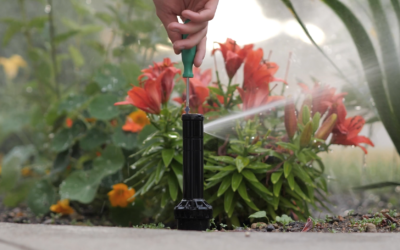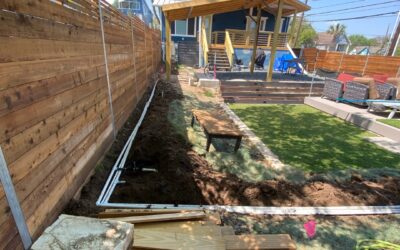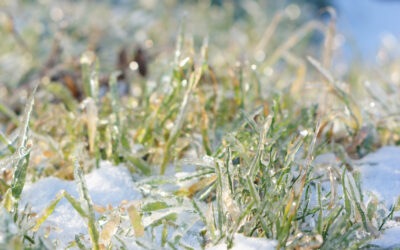A Detailed Cost Guide to Sprinkler & Irrigation Systems
For anyone considering a sprinkler system, understanding the sprinkler system cost is essential for effective budgeting. The cost can vary significantly depending on your property’s size, the type of system, and specific installation requirements. In this guide, we’ll break down these factors to help you plan your landscaping investment, avoid unexpected costs, and determine the best system for your lawn and garden.
Factors Influencing Sprinkler System Cost
The overall cost of a sprinkler system is determined by multiple factors. Knowing these will help you select the right system for your needs and budget.
Property Size and Layout
The size and shape of your property directly impact the sprinkler system cost. Larger lawns require more pipes, sprinkler heads, and potentially a larger control system to cover the area adequately, increasing both material and labor costs. Complex layouts with flower beds, trees, and gardens may require additional zoning and customized setup, which can add to installation costs.
To explore options tailored to your lawn’s size, check out our Sprinkler Install services.
Types of Sprinkler Systems
Different types of sprinkler systems come with varying price points:
- Basic Sprinkler Systems: Traditional systems with fixed or rotary heads are often the most cost-effective but may lack the advanced features of smart systems.
- Drip Irrigation Systems: These systems are designed for specific garden zones or flower beds, delivering water directly to the roots and conserving water. They can be more expensive to install initially due to the specialized components.
- Smart Irrigation Systems: These systems use sensors and weather data to adjust watering schedules, conserving water and reducing monthly bills. They generally have a higher upfront cost but can be more economical in the long run.
For more information on choosing efficient systems, visit the EPA WaterSense Program, which provides guidance on water-saving irrigation systems.
Water Source and Backflow Prevention
The source of your water supply affects both sprinkler system installation and costs. Systems connected to municipal water require a backflow prevention device to ensure that water does not contaminate the main supply. In some areas, these devices are mandatory and add to the installation costs. Private well systems may also require filtration, further affecting total expenses.
Soil Type and Terrain
Soil type impacts water absorption, meaning your lawn may need a particular type of sprinkler head or spacing to achieve optimal results. For example, sandy soil absorbs water quickly but requires more frequent watering, while clay soil retains moisture longer. Sloping terrain may also need specialized zoning to prevent runoff and ensure even coverage.
Seasonal Adjustments and Maintenance Needs
The cost of a sprinkler system includes not only installation but ongoing maintenance. Systems may need seasonal adjustments to work efficiently throughout the year. For example, winterizing your system is essential in colder climates to prevent pipe damage. These maintenance needs can add to the long-term sprinkler system cost. For more resources on maintaining irrigation systems, visit the Irrigation Association.
Average Cost Ranges for Sprinkler System Installation
The following cost estimates can help you budget for a new sprinkler system installation based on property size:
Small Yards (up to 1/4 acre)
For properties under a quarter of an acre, the sprinkler system cost generally ranges from $1,500 to $3,000. This estimate covers materials, basic installation, and zoning for small lawns.
Medium Yards (1/4 to 1/2 acre)
For medium-sized yards, installation costs average between $3,000 and $5,000. These systems usually involve more sprinkler heads, piping, and potentially a programmable controller for zone-based watering.
Large Yards (1/2 acre or more)
For properties over half an acre, expect to pay $5,000 and up. Large properties often require complex zoning, smart controls, and custom layouts to ensure complete coverage. The installation process for these larger areas is also more labor-intensive.
Additional Costs to Consider
Beyond basic installation, there are additional costs that can influence your sprinkler system budget.
Smart Controls and Sensors
Adding smart controls and soil moisture sensors to your system increases the initial cost but can lead to long-term savings on your water bill. These controls use real-time data to adjust watering schedules automatically, conserving water and reducing unnecessary irrigation.
Permits and Inspections
Depending on your location, you may need permits or inspections for new installations, particularly if a backflow prevention device is required. Permit costs vary, so check with your local government or HOA to understand any additional fees.
Landscape Restoration
Some installation methods may disturb existing landscaping, especially if trenching is required. The cost of restoring sod, plants, or hardscaping features should be factored into your budget if landscaping modifications are needed.
Cost-Saving Tips for Sprinkler Systems
To keep your sprinkler system cost within budget, consider these strategies:
Start with Basic Features
If you’re on a budget, consider starting with a basic system, then adding upgrades like smart controllers or drip irrigation zones as needed. This approach helps you manage costs and spread out investments over time.
Install During the Off-Season
Some companies offer discounts for installations in late fall or early spring, when demand is lower. Scheduling installation during the off-season can yield significant savings.
Choose Water-Efficient Components
Opting for high-efficiency sprinkler heads, low-flow nozzles, or a smart controller can help reduce water waste and lower utility bills. The savings on your water bill will offset the initial cost of these components over time.
For more water-efficient landscaping ideas, visit Smart Water Application Technologies (SWAT).
Why Invest in a Quality Sprinkler System?
Investing in a high-quality sprinkler system provides numerous benefits, from saving water to keeping your landscape looking its best. While the initial sprinkler system cost may seem significant, the long-term benefits of healthier landscaping, water conservation, and reduced maintenance make it worthwhile. A professionally installed system ensures even watering, helps prevent lawn diseases, and improves curb appeal, adding value to your property.
Frequently Asked Questions About Sprinkler System Costs
How much does it cost to run a sprinkler system?
The monthly cost of running a sprinkler system depends on water rates, your watering schedule, and lawn size.
Is a smart sprinkler system worth the cost?
Yes, smart systems optimize water usage, making them more efficient than traditional systems. They reduce water waste, adjust for weather changes, and can result in long-term cost savings.
Can I install a sprinkler system myself to save money?
While DIY installation may reduce upfront costs, professional installation ensures optimal design, water efficiency, and proper zoning. For long-term savings and reliable performance, professional installation is often worth the investment.
Schedule Your Sprinkler Installation with Heartland Sprinklers
Ready to enhance your landscape with a professional sprinkler system? Heartland Sprinklers offers tailored installation and maintenance services to fit your property’s unique needs. Contact us today to schedule a consultation and receive a custom quote, ensuring your lawn stays green and healthy year-round.



